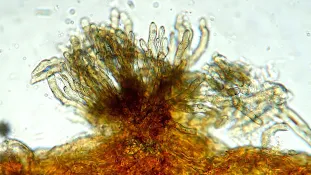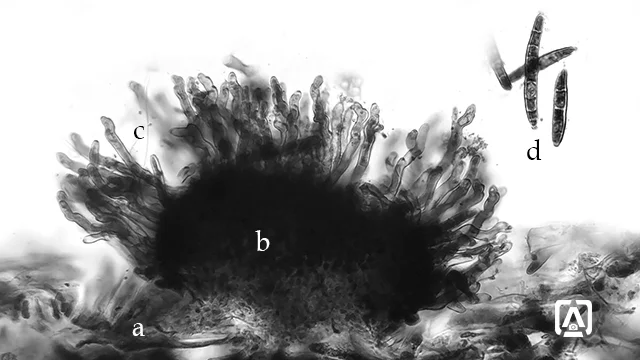Tikka disease of groundnut
Leaf spot (early and late) of groundnut
Host: Groundnut (Arachis hypogaea L.)
Pathogens: Cercospora arachidicola Hor and Cercosporidium personatum (Berk & Curt.) Deighton
Pathogens: Cercospora arachidicola Hor and Cercosporidium personatum (Berk & Curt.) Deighton
Distribution
Tikka disease is the most prevalent and destructive disease of groundnuts all
over the world. It infects groundnut in all the areas where the crop is grown. Tikka
disease of groundnut causes up to 50 % loss globally (Tshilenge-Lukanda et al.,
2012) and up to 70 % loss (Mushrif et al., 2017) in the Indian subcontinent. The
disease is favored by hot and wet conditions.
Symptoms
 |
| Groundnut leaves showing Tikka disease (early leaf spot) |
Symptoms appear in
two stages; an early leaf spot caused by Cercospora arachidicola while,
late leaf spot caused by Cercosporidium personatum. Early leaf spot
begins to develop on the upper surface of lower leaves. These are brown to
reddish brown in color always surrounded by yellow halo. Initially, the spots
are circular but, later more than one spot coalesce and become irregular. Early
leaf spots are raised on the upper surface, while smooth at lower.
 |
| Groundnut leaves showing Tikka disease (late leaf spot) |
Late leaf spots
appear late in the season. These are dark brown to black colored and usually do
not have yellow halo. In contrast to the
early spot, most of the spores/conidia are born at the lower surface, giving a raised
appearance, while the upper surface is nearly smooth.
Pathogen
 |
| Conidiophores of Cercospora |
Early leaf spot is caused by Cercospora arachidicola
while late leaf spot is caused by Cercosporidium personatum (Syn. Cercospora
personata). The perfect stage of the two are Mycosphaerella arachidicola
Jenkins and Mycosphaerella berkeleyii Jenkins respectively. The prefect
stages are reported from the USA. The
mycelium of Cercospora arachidicola are both external and internal (intra
as well as intercellular) lacking haustorium, whereas, Cercosporidium
personatum has internal mycelium with haustorium. Mycelium produces dense
stroma in the stomatal chamber, from which non-septate, geniculate (knee-shaped
bending) conidiophores are born. Conidia are cylindrical, septate and pale-brown
colored.
 |
| Section of groundnut leaves passing through the spots. a: host tissues, b: fungal stroma arising from stomatal chamber, c: conidiphores with knee-shaped bending, d: conidia |
Control measures
- As the primary inoculum survives in the debris, burning of the debris reduces the primary infection.
- Early sowing reduces the disease intensity.
- Crop rotation of two to three years suppresses the disease.
- Resistant varieties (such as ICGV 89104, ICGV 91114 (EM), ICGV 920920, ICGV 92093 (MM)) should be sown.
- Seed should be treated in 0.5 % CuSO4 solution for half an-hour.
- Secondary infection can be prevented by spraying with fungicides.
- Three Spray of Bordeaux mixture (4:4:50) with linseed oil (to make sticky) at 15 days interval from 40 days of seed sowing prevent the disease development.
- Spray of systemic fungicide, Bavistin (Carbendazim) or Agrozim @ 2 g/liter of water and 250 liters/ha (100 liters/acre) in 40 day's plants after irrigation prevents the disease infection.
- Spray of biocontrol agents Trichoderma viride (5 %) and Verticillium lecanii (5 %) check the growth of pathogens.
References
- MUSHRIF, S., MANJU, M. and NAGARAJU, T.S., (2017) Comparative efficacy of fungicides against tikka disease of groundnut caused by Cercospora arachidicola and Cercosporidium personatum.
- Tshilenge-Lukanda, L., KKC, N., Kalonji-Mbuyi, A. and RV, K., 2012. Epidemiology of the groundnut (Arachis hypogaea L.) leaf spot disease: Genetic analysis and developmental cycles. American Journal of Plant Sciences, 2012.
See also
Content first created on 03-10-2020
last updated on 24-11-2022
last updated on 24-11-2022





